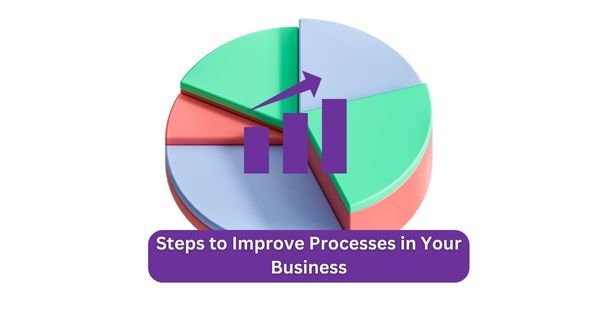Running a successful business requires efficient and streamlined processes. By continuously improving these processes, you can improve productivity, reduce costs, and deliver better customer results. In this article, we’ll explore five simple steps to help you improve your business processes, allowing you to optimize your operations and achieve tremendous success.
Table of Contents
ToggleIdentify Existing Processes
The first step to improve processes in your business is to identify and understand the existing processes in your organization. Take the time to map out each process and document the steps involved. This will give you a clear picture of how things are currently going and help you identify inefficiencies or bottlenecks that need improvement.
Pay attention to operational and administrative processes and customer contact processes. During the identification phase, consider the involvement of employees from different departments.
They have first-hand experience with processes and can provide valuable insights. Also, gather any existing documentation, such as standard operating procedures (SOPs), to ensure a complete understanding of the processes.
Analysis and Evaluation
Once you’ve defined your processes, it’s time to analyze and evaluate their effectiveness. Let’s take a closer look at each process and examine it in detail. Look for areas where tasks are taking longer than necessary, where there are unnecessary steps or duplicate efforts.
Identify key performance indicators (KPIs) relevant to each process and evaluate how well they have been achieved. This analysis will provide valuable information on areas for improvement.
During the analysis, consider the involvement of employees directly involved in the processes. Their input and perspective can shed light on weaknesses and potential improvements. Plus, collect process-related data and metrics to better understand their performance.
This can include cycle times, throughput, defect rates, and customer satisfaction rates. Also, consider comparing your processes with industry or competitor best practices. This will help you identify areas where your process may be slow and provide insights into areas for improvement.
Streamline and Automate
After analyzing your processes, it’s time to streamline and automate them. Look for opportunities to simplify the steps by eliminating redundant or non-value-added tasks. Focus on optimizing workflow and minimizing unnecessary transfers or delays. Consider rearranging responsibilities and roles, if necessary, to ensure smoother operations.
Besides streamlining, leverage technology to automate manual processes. Identify areas where technology can be deployed to improve efficiency and reduce the possibility of human error. This could include implementing software solutions, using tools that automate workflows, or using artificial intelligence to streamline operations. To focus on more strategic tasks, automation saves time and frees up resources.
When implementing automation, ensure the proper training and change management processes are in place. Communicate the benefits and purpose of automation to employees and provide training to help them adapt effectively to change.
Make Continuous Improvement
Process improvement is not a one-time task but an ongoing effort. In your organization, create a culture of continuous improvement. Encourage employees to provide feedback and suggestions to improve processes in your business. Regularly review and update your processes to adapt to changing business needs and market conditions. By continuously searching for ways to optimize operations and achieve lasting results, you can stay ahead of your competitors.
Set up feedback and recommendation channels to foster a continuous improvement culture. Make it easier to communicate and provide opportunities for employees to contribute ideas. Implement regular audit cycles where processes are evaluated and updated as needed. This ensures that your business remains agile and responsive to changing needs.
Consider implementing methods like Lean Six Sigma or Kaizen to systematically identify and eliminate waste in your processes. These methods provide structured approaches to process improvement and can help drive lasting change.
Monitor and Adjust
Once you’ve made changes to your processes, monitoring their performance and making any necessary adjustments is essential. Set up metrics to track the effectiveness of improved processes. Monitor previously defined KPIs and compare them to desired goals.
If discrepancies are identified, investigate the root cause and make necessary adjustments. Regular monitoring and adjustment ensure that your processes remain efficient and aligned with your business goals.
Monitoring can be done through regular reporting and data analysis. Use information from monitoring to identify areas for further improvement. Encourage employee feedback and involve them in the follow-up process to ensure a comprehensive process review.
Consider implementing a process data collection and management system, such as a business intelligence tool or dashboard. This will provide real-time visibility into process performance and enable data-driven decision-making.
What are the Steps to Improve Processes in Your Business?
Business process improvement is locating and enhancing an already-existing procedure to increase efficiency. Simply put, you take a process and find a better way.

Numerous regular procedures, such as processing orders and approving trip requests, could be essential to your company. Each is essential for the proper functioning and prosperity of your business. But these processes can only be efficient if they are updated or done manually, which can lead to financial loss and loss of valuable time. Research by IDC shows that companies lose about 20-30% of annual revenue due to inefficient processes. The financial impacts of these inefficient processes get worse the longer they last.
Tools to Help You Improve Processes in Your Business and Productivity
According to Capterra, project management software offers several benefits for improving your team’s processes and productivity, which explains why it’s such an integral part of most people’s day-to-day operations groups.
Better time estimates (60%), more effective resource usage (55%), and improved team communication (49%) are a few of the top advantages mentioned. What are some project management tools you can use to improve your process?
There are plenty of options, including Infinity, Airtable, Wrike, Clickup, Trello, Asana, and more. Each of these tools has its advantages and disadvantages, but the most important thing is that they will help you improve your business processes in the long run.
Other helpful software includes various customer communication tools, such as surveys and lives chat tools that integrate with your CRM to help you get consumer feedback and determine customer satisfaction. Inefficiencies and understanding the impact of your process bottlenecks.
Guiding Principles
To maximize your chances of success, you must follow the following principles:
- Focus on processes that have a disproportionate impact on revenue or profitability. Success in process improvement is ultimately about execution.
- Choose goals that you have a realistic chance of achieving based on your organization’s ability to perform.
- Make sure employees understand the goals. Poor adoption is the number one reason process improvement projects fail. Getting people to change their habits is easier if they need help understanding why.
- Make sure you can measure your progress. Achieving ambitious objectives is essential, but to implement process improvement projects, you need to be sure that the metrics set are applied continuously.
- Get advice. The business environment is changing rapidly, and having an independent perspective will help you choose the right goals and implement them most effectively and profitably.
Conclusion
Improving the processes in your business is an ongoing journey. You can change behavior and improve efficiency with the five simple steps in this article. Remember to identify existing processes, analyze and evaluate them, streamline and automate them where possible, implement a culture of continuous improvement, and monitor and adjust for continued success. Adopting process improvement will benefit your organization internally, improve customer satisfaction, and drive sustainable growth.
Frequently Asked Questions
The time it takes to improve a business process varies depending on the complexity of the process and how much change is needed. It is an ongoing endeavour that requires constant evaluation and adjustment.
Common challenges include resistance to change, lack of employee engagement, insufficient resources, and difficulty identifying areas for improvement. However, effective communication, staff involvement and a systematic way of improving process performance can overcome these challenges.
Yes, employee engagement is critical to successful process improvement. They’re usually doing their job well and understand the challenges and opportunities for improvement. Their participation promotes ownership and increases the likelihood of successful implementation.
Yes, various tools and software are available to help with process improvement, such as workflow automation tools, project management software, and business process management (BPM) systems. These tools can streamline operations, improve collaboration, and provide valuable insights for optimization.
Improving business processes offers several benefits, including increased efficiency, reduced costs, increased productivity, improved customer satisfaction, better decision-making based on insights, and more. Data and competitive advantage in the market.









